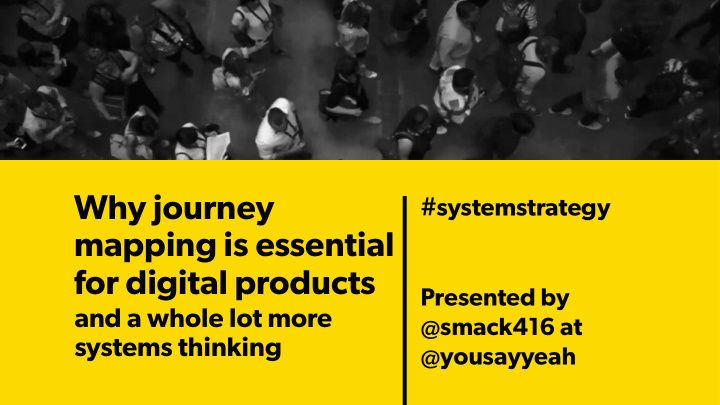



Why journey #systemstrategy mapping is essential for digital products Presented by and a whole lot more @smack416 at systems thinking @yousayyeah
Designers. Developers. Product owners. Business leaders.
1. Problem 2. Foundation 3. Solution 4. Outcomes
1. Problem We think in terms of products instead of systems. @smack416 #systemstrategy
Design for people.
So many UX research and validation methods are focused on individual or existing products.
Improve engagement. Optimize funnels. Measure adoption. Test usability.
Survey. Interview. Workshop. Prototype.
Outcomes, not features.
We’ve learned to be lean and run sprints.
How do we choose which product to focus on? Is this an outcome that will improve adoption or engagement? How do we improve the experience of this product?
Despite our best e ff orts of designing for people, we’re failing them.
People use multiple devices and channels to accomplish any number of goals.
People also make decisions and are influenced by factors unrelated to your business.
Organizations are complex systems unto themselves.
Focusing on one product or solution at a time is not enough.
We need to take a wider view in order to increase the impact and value of our work.
From product view. Powers of Ten (1977)
To system view. Powers of Ten (1977)
2. Foundation You need to understand the systems you’re designing for. @smack416 #systemstrategy
Consider who you’re designing for.
You’re designing for people.
You’re designing for a business or organization.
You need to balance the needs of people with organizational goals and capabilities.
Individually , both the people and organizations you design for operate in complex systems.
The relationship between the two groups becomes even more complicated, and symbiotic.
Organizations consist of a variety of people with varying responsibilities, capabilities, and motivations.
The people the organizations serve have their own needs and motivations, independent of the organization.
Both organizations & people want to generate value for themselves.
The winning mindset: Organizations exist to serve people.
So you have two complex systems, each deriving more value from one another the closer they align.
The better you understand these systems, the closer you can align them.
3. Solution Map the system and you’ll have a treasure map to success. @smack416 #systemstrategy
The topographic foundation of your treasure map: The customer journey map.
The customer journey is the path a person takes to solve a problem or reach a goal.
For your organization, you likely want that path to include purchasing and using your product or service.
But customers won’t necessarily interact with your organization.
Organizations who map only the touchpoints they control are not doing their job.
So how do we map a customer journey e ff ectively.
Your customer’s journey will vary based on how they choose between your organization or any alternative ways of meeting their needs.
Your job is to identify that selection process and those key decision-making stages.
How do you do this? Research.
Interviews. Observation. Any other tactics to help you determine your customer’s decision-making process.
Talk to your customers. Talk to your sales and support sta ff . Talk to people who have purchased related products.
Ask people how they identify and solve the problem your organization is looking to solve.
Example stages of a customer journey. Stages Problem Identi f cation Problem Analysis Internal Discussion of Options External Resear
Your customer’s stages will be di ff erent.
If you have various types of customers, each of them may even follow di ff erent stages.
What the user is trying to accomplish. What tasks they’ll perform to get there. Their state of mind at the time.
Recommend
More recommend